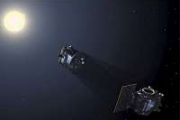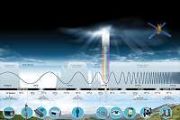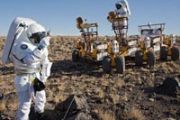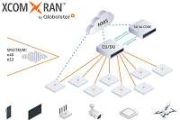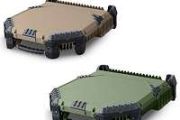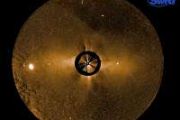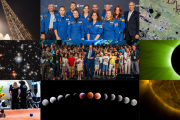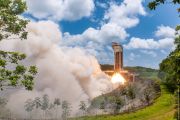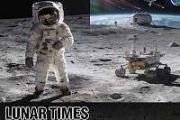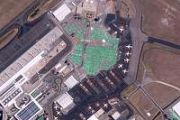
Copernical Team
Advancing satellite methods for mapping coastal seabeds
 Researchers from Flinders University are pioneering cost-effective techniques for collecting essential coastal elevation data, known as bathymetry, by leveraging satellite technology to monitor environmental shifts along South Australia's coastline.
"High-precision traditional technologies such as topographic profiling, boat-based echo sounders and sonar are currently the best available me
Researchers from Flinders University are pioneering cost-effective techniques for collecting essential coastal elevation data, known as bathymetry, by leveraging satellite technology to monitor environmental shifts along South Australia's coastline.
"High-precision traditional technologies such as topographic profiling, boat-based echo sounders and sonar are currently the best available me South Africa China achieve milestone with 12900 km quantum satellite connection
 Scientists from South Africa and China have achieved a historic milestone in quantum communication by creating the world's longest ultra-secure quantum satellite link, spanning an unprecedented 12,900 km. This link, established using the Chinese quantum microsatellite Jinan-1 in low Earth orbit, is also the first of its kind ever implemented in the Southern Hemisphere.
The collaboration be
Scientists from South Africa and China have achieved a historic milestone in quantum communication by creating the world's longest ultra-secure quantum satellite link, spanning an unprecedented 12,900 km. This link, established using the Chinese quantum microsatellite Jinan-1 in low Earth orbit, is also the first of its kind ever implemented in the Southern Hemisphere.
The collaboration be BlackSky advances AI-powered space intelligence with critical design review success
 BlackSky Technology Inc. (NYSE: BKSY) has reached a significant milestone by completing a critical design review (CDR) for a major international defense partner. This accomplishment confirms that BlackSky's upcoming next-generation architecture, anchored by its Gen-3 satellite constellation, will provide rapid, secure, AI-driven intelligence in near real time.
"Completing the CDR is a monu
BlackSky Technology Inc. (NYSE: BKSY) has reached a significant milestone by completing a critical design review (CDR) for a major international defense partner. This accomplishment confirms that BlackSky's upcoming next-generation architecture, anchored by its Gen-3 satellite constellation, will provide rapid, secure, AI-driven intelligence in near real time.
"Completing the CDR is a monu T2S Solutions acquires Blue Marble to bolster space technology portfolio
 T2S Solutions ("T2S"), a founder-led enterprise focused on delivering advanced technologies for U.S. defense, intelligence, and national security, has announced the acquisition of Blue Marble Communications ("Blue Marble"), a specialized developer of space-grade communication and computing solutions.
As global demand intensifies for robust, high-speed technologies in satellite and spacefli
T2S Solutions ("T2S"), a founder-led enterprise focused on delivering advanced technologies for U.S. defense, intelligence, and national security, has announced the acquisition of Blue Marble Communications ("Blue Marble"), a specialized developer of space-grade communication and computing solutions.
As global demand intensifies for robust, high-speed technologies in satellite and spacefli Space Forge secures UK approval to launch first orbital manufacturing satellite
 Space Forge has achieved a historic milestone in the UK space industry by securing a launch licence from the UK Civil Aviation Authority (CAA) for its ForgeStar-1 satellite, the nation's first in-orbit advanced manufacturing platform. Scheduled for deployment later in 2025, ForgeStar-1 will mark Wales' inaugural ISAM (In-Space Advanced Manufacturing) mission and reinforce Space Forge's leadershi
Space Forge has achieved a historic milestone in the UK space industry by securing a launch licence from the UK Civil Aviation Authority (CAA) for its ForgeStar-1 satellite, the nation's first in-orbit advanced manufacturing platform. Scheduled for deployment later in 2025, ForgeStar-1 will mark Wales' inaugural ISAM (In-Space Advanced Manufacturing) mission and reinforce Space Forge's leadershi A new wave of mini satellites to monitor the high energy universe
 The H.E.R.M.E.S. Constellation, operated by the Italian Space Agency (ASI), successfully embarked on its pathfinder mission following a launch aboard SpaceX's Transporter 13 mission. Lift-off occurred at 7:43 AM Italian time from Vandenberg Space Force Base in California, with the constellation's six CubeSats secured aboard an ION release platform developed by Italian aerospace firm D-Orbit and
The H.E.R.M.E.S. Constellation, operated by the Italian Space Agency (ASI), successfully embarked on its pathfinder mission following a launch aboard SpaceX's Transporter 13 mission. Lift-off occurred at 7:43 AM Italian time from Vandenberg Space Force Base in California, with the constellation's six CubeSats secured aboard an ION release platform developed by Italian aerospace firm D-Orbit and Oxygen detected in most distant galaxy: 'astonished' astronomers
 Oxygen has been detected in the most distant galaxy ever discovered, surprised astronomers said Thursday, offering further evidence that stars in the early universe matured far quicker than had been thought possible.
The galaxy JADES-GS-z14-0, which was discovered by the James Webb Space Telescope last year, is so far away that its light took 13.4 billion years to reach Earth.
This means
Oxygen has been detected in the most distant galaxy ever discovered, surprised astronomers said Thursday, offering further evidence that stars in the early universe matured far quicker than had been thought possible.
The galaxy JADES-GS-z14-0, which was discovered by the James Webb Space Telescope last year, is so far away that its light took 13.4 billion years to reach Earth.
This means New DESI results strengthen hints that dark energy may evolve
 The discovery of dark energy, nearly 30 years ago, was already the biggest surprise of my scientific lifetime," said David Weinberg, a professor of astronomy at Ohio State who also contributed to the DESI analysis. "These new measurements offer the strongest evidence so far that dark energy evolves, which would be another mind-blowing change to our understanding of how the universe works."
The discovery of dark energy, nearly 30 years ago, was already the biggest surprise of my scientific lifetime," said David Weinberg, a professor of astronomy at Ohio State who also contributed to the DESI analysis. "These new measurements offer the strongest evidence so far that dark energy evolves, which would be another mind-blowing change to our understanding of how the universe works." From Contract to Orbit in Record Time for OroraTech Satellite Deployment
 Rocket Lab USA, Inc. (Nasdaq: RKLB) ("Rocket Lab" or "the Company"), an established leader in space systems and launch solutions, has confirmed the rapid scheduling of an Electron mission for OroraTech, a Germany-based specialist in wildfire detection and monitoring technologies.
The mission, titled "Finding Hot Wildfires Near You," is slated for liftoff during a window beginning March 27t
Rocket Lab USA, Inc. (Nasdaq: RKLB) ("Rocket Lab" or "the Company"), an established leader in space systems and launch solutions, has confirmed the rapid scheduling of an Electron mission for OroraTech, a Germany-based specialist in wildfire detection and monitoring technologies.
The mission, titled "Finding Hot Wildfires Near You," is slated for liftoff during a window beginning March 27t ATLAS joins Viasat to enhance NASA's satellite ground services
 ATLAS Space Operations has partnered with satellite communications leader Viasat, Inc. to deliver essential support for NASA's current and future missions. Viasat, among the initial group of four firms awarded Task Orders under NASA's Near Space Network (NSN) Services contract, will deploy its Real-Time Earth (RTE) network globally to boost NASA's Direct-to-Earth (DTE) communications capabilitie
ATLAS Space Operations has partnered with satellite communications leader Viasat, Inc. to deliver essential support for NASA's current and future missions. Viasat, among the initial group of four firms awarded Task Orders under NASA's Near Space Network (NSN) Services contract, will deploy its Real-Time Earth (RTE) network globally to boost NASA's Direct-to-Earth (DTE) communications capabilitie 



